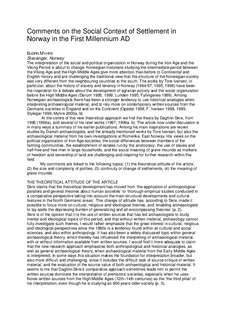| dc.description.abstract | The interpretation of the social and political organization in Norway during the Iron Age and the Viking Period is about to change. Norwegian historians studying the intermediate period between the Viking Age and the High Middle Ages give more attention than before to Continental and English history and are challenging the traditional view that the structure of the Norwegian society was very different from the neighbouring countries to the south. The works by Tore Iversen, in particular, about the history of slavery and tenancy in Norway (1994/97, 1995, 1996) have been the inspiration for a debate about the development of agrarian society and the social organization before the High Middle Ages (Dørum 1995, 1999, Lunden 1995, Fyllingsnes 1999). Among Norwegian archaeologists there has been a stronger tendency to use historical analogies when interpreting archaeological material, and to rely more on contemporary written sources from the Germanic societies in England and on the Continent (Opedal 1998, F. Iversen 1998, 1999, Stylegar 1999, Myhre 2000a, b).
At the centre of this new theoretical approach we find the thesis by Dagfinn Skre, from 1996 (1998a), and several of his later works (1997, 1999a, b). The article now under discussion is in many ways a summary of his earlier publications. Among his main inspirations are recent studies by Danish archaeologists, and the already mentioned works by Tore Iversen, but also the archaeological material from his own investigations at Romerike, East Norway. His views on the political organization of Iron Age societies, the social differences between members of the farming communities, the establishment of estates run by the aristocracy, the use of slaves and half-free and free men in large households, and the social meaning of grave mounds as markers of freedom and ownership of land are challenging and inspiring for further research within this field.
My comments are linked to the following topics; (1) the theoretical attitude of the article, (2) the size and complexity of polities, (3) continuity or change of settlements, (4) the meaning of grave mounds. | no_NO |
